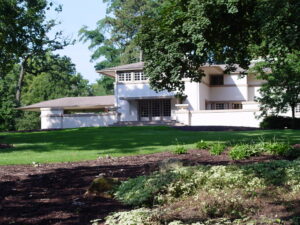
Stewart House
Before closing up his Oak Park studio in Chicago and heading to Europe in late 1909, Frank Lloyd Wright put together blueprints for what would

You’re in the Wright Place!
The Prairie style of architecture is a style of American architecture that was popular in the early 20th century. It is characterized by its horizontal lines, open floor plans, and use of natural materials. The Prairie style was developed by Frank Lloyd Wright, who was influenced by the Arts and Crafts movement and the Japanese aesthetic.
Wright believed that architecture should be organic, meaning that it should be in harmony with its environment. He also believed that architecture should be democratic, meaning that it should be accessible to everyone. The Prairie style is an expression of these principles.
Wright’s Prairie style houses are often located in rural areas, where they can take advantage of the natural landscape. They are typically one-story, with a low-pitched roof and large windows. The interior of a Prairie style house is open and spacious, with a focus on natural light.
Wright’s Prairie style houses have had a significant influence on American architecture. They have inspired generations of architects and homeowners, and they continue to be admired for their beauty and simplicity.
One of the most famous examples of Prairie style architecture is the Robie House in Chicago, Illinois. The Robie House was designed by Wright in 1909, and it is considered one of the most important buildings in the Prairie style. The Robie House is a two-story house with a low-pitched roof and a large fireplace. The interior of the house is open and spacious, with a focus on natural light.
Another famous example of Prairie style architecture is the Fallingwater house in Mill Run, Pennsylvania. Fallingwater was designed by Wright in 1937, and it is considered one of the most famous buildings in the world. Fallingwater is a house that is built over a waterfall, and it is an example of Wright’s use of natural materials and his focus on harmony with the environment.
Wright’s Prairie style of architecture has had a significant influence on American architecture. His houses are admired for their beauty and simplicity, and they continue to be an inspiration to architects and homeowners alike.
This page may contain affiliate links. See our disclosure about affiliate links here.

Before closing up his Oak Park studio in Chicago and heading to Europe in late 1909, Frank Lloyd Wright put together blueprints for what would

The Allen House was completed in 1918 for Elsie and Henry Allen in Wichita, Kansas. The home was Wright’s last prairie house. Photo Credit: “DSC_0101”

Tucked away in Wilmette, Illinois, lies the Burleigh House, a testament to Frank Lloyd Wright’s innovative vision. Built in 1916, this residence exemplifies the architect’s

That Frank Lloyd was a famous architect of the Prairie School style is a well-known fact. Contrary to what some might like to believe, he

Dr. Peter Fahrney – whose wealth resulted from the manufacture and patenting of medicines – had five children: four sons and a daughter, Susan Emma.

Homes built in the United States during the Victorian Era (from 1837 to 1901, the length of the rule of Britain’s Queen Victoria) were overly

Architecture and home design have always fascinated me. As a young girl I enjoyed drawing floor plans, rearranging my parent’s furniture and playing with Lincoln Logs and Legos. My passion has always been the architecture of Frank Lloyd Wright. Since I have been old enough to drive a car, I have visited Frank Lloyd Wright homes in the Chicagoland area and attended the Wright Plus house walks. Now, as co-owners of Northern Sky Designs, my husband & I are able to combine our website design skills and FLW travels to bring you this website! Enjoy!